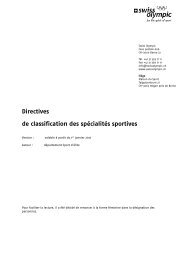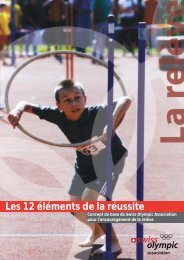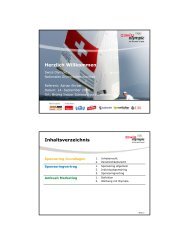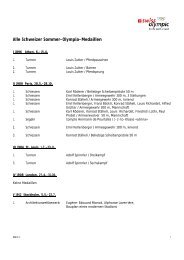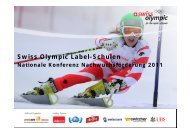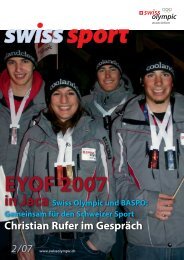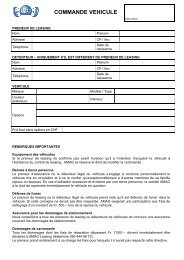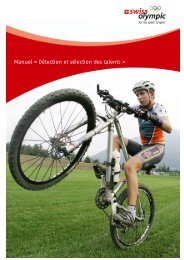UEFA EURO 2008⢠Sustainability Report - Bundesamt für Sport ...
UEFA EURO 2008⢠Sustainability Report - Bundesamt für Sport ...
UEFA EURO 2008⢠Sustainability Report - Bundesamt für Sport ...
You also want an ePaper? Increase the reach of your titles
YUMPU automatically turns print PDFs into web optimized ePapers that Google loves.
Photo: BKW FMB Energie AG<br />
:0<br />
ensured an advance supply of a total of<br />
1.4 GW-h (more than the amount actually<br />
used in the stadium). For the match<br />
locations in Klagenfurt and Salzburg, green<br />
electricity source certificates were credited<br />
to Euro 2008 SA for the electricity used.<br />
The green electricity used in Austria was<br />
comprised as follows: 75% water power<br />
(small water power plants), 16% wind<br />
power, 7% electricity from biomass/biogas<br />
and 2% solar power.<br />
To reduce the use of consumption of<br />
electricity, special energy-efficient coolers<br />
(“eKOfreshment”) provided by beverage<br />
supplier Coca-Cola were used in the stadia,<br />
fan zones and public viewings. Using<br />
a use-controlled energy management<br />
system, these consumed around 35% less<br />
electricity than customary coolers and are<br />
operated with an especially environmentally-friendly<br />
cooling agent that does not<br />
contain fluorocarbons. A total of 2,682<br />
coolers were used by Coca-Cola during<br />
the <strong>EURO</strong> 2008, among which were 1,311<br />
“eKOfreshments” (= 49%). All the coolers<br />
will remain in use in Austria and Switzerland<br />
after the <strong>EURO</strong> 2008 and replace<br />
older equipment.<br />
Photo: brainbows<br />
CO 2<br />
balance sheet / compensation<br />
Despite all the efforts to avoid and reduce<br />
the consumption of energy and the emission<br />
of greenhouse gases, significant<br />
amounts of energy are consumed and<br />
greenhouse gases emitted at a large sporting<br />
event. The host nations had greenhouse<br />
gas balance sheets drawn up by<br />
two external research institutes, whereby<br />
the methodology and system boundaries<br />
were matched between the two as far as<br />
possible.<br />
The results of the greenhouse gas balance<br />
sheet for the <strong>EURO</strong> 2008, in comparison<br />
to other large events – such as the 2006<br />
Football World Cup in Germany – provided<br />
some interesting results. Within the<br />
scope of the „Green Goal“ a volume of<br />
around 100,000 tons of CO 2<br />
equivalents<br />
was calculated to be generated as a result<br />
of travel to and from the stadia, energy<br />
consumption as a result of the construction<br />
and operation of the stadia and<br />
overnight stays by those visiting the stadia<br />
in Germany. Applying this method to the<br />
<strong>EURO</strong> 2008 results in 11,600 tons of CO 2<br />
equivalents for Switzerland and Austria.<br />
When making a comparison it must be<br />
considered that narrower system limits<br />
were used to create the balance sheet in<br />
Germany, however, and that a Football<br />
44




